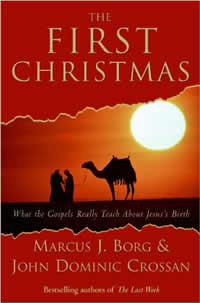Book Notes
 Marcus Borg and John Dominic Crossan, The First Christmas; What the Gospels Really Teach About Jesus's Birth (San Francisco: Harper, 2007), 258pp.
Marcus Borg and John Dominic Crossan, The First Christmas; What the Gospels Really Teach About Jesus's Birth (San Francisco: Harper, 2007), 258pp.
Readers acquainted with the several popular books by these two prominent New Testament scholars will find no surprises here but rather familiar terrain. The current volume serves as a companion to their earlier work about Easter, complete with its presumptuous subtitle, The Last Week; What the Gospels Really Teach About Jesus's Final Days in Jerusalem (2006). Since the Gospels of Mark and John don't include any birth narratives, this book is in essence a simple exposition of Matthew 1-2 and Luke 1-2.
Borg and Crossan try to squeeze maximal theological meaning out of minimal historical facts. For them the nativity stories are not historical narratives, but neither are they mere fables. They suggest a third option, that the birth stories are metaphorical or parabolic in nature and therefore "about meaning, not factuality." This doesn't require that you deny the factuality of the birth narratives, they claim, "it simply sets that question aside." In practice, though, they conclude that the nativity stories contain a bare minimum of history—"probably just the three items that Jesus was a historical figure whose parents were Mary and Joseph and whose home was at Nazareth in Galilee" (p. 38, cf. 82, 184).
This begs the question how beginning with such bare bones data you arrive at what they call a "surplus of meaning," and, even more importantly, how you arrive at a "deeply subversive" and "pervasively anti-imperial" nativity message. The "parabolic" stories about Jesus's birth, they argue, challenge any and all imperial authority. Jesus is the "new Moses" who challenges King Herod, the "new Pharaoh." Whereas Rome promised "peace through violent victory with Caesar," the nativities announce "peace through non-violent justice with Christ" (p. 154).
I'm dubious about historical deconstructions two millennia after the events that claim to know more and to know better than the first witnesses, that do not give compelling explanations about how and why the first recorders got things so badly wrong and yet attracted the allegiance of so many converts (who must have known they were "wrong" about the literal facts), or that insinuate that early believers were more gullible about what we today find "impossible to believe." Borg and Crossan do a fine job of illuminating the religious background of first century Judaism, and the cultural and political background of the Roman empire, showing how the Biblical texts and these two contexts interact. They affirm that the birth of Jesus signaled a deeply personal salvation ("peace of mind") but emphasize the "magnificent reversal" and "stunning subversion" of all political pretensions of the state ("peace on earth").


